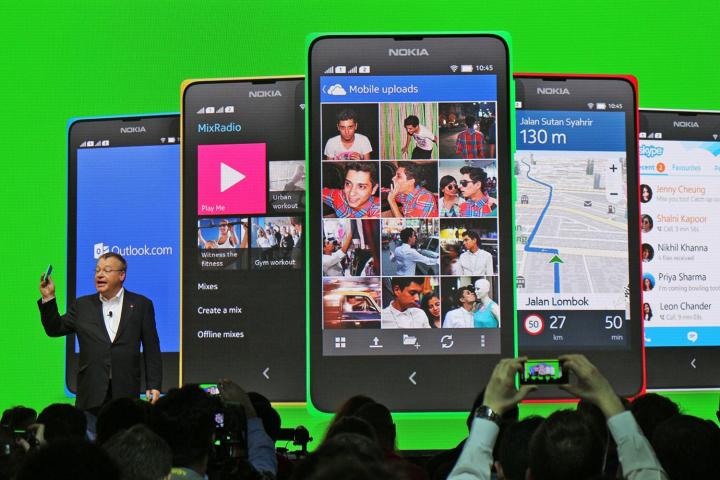
What do you do when you aren’t ready to give up, but your rival is more than 25 times more popular than you? If you’re Microsoft, you throw a costume party.
Yesterday, Nokia (Microsoft is purchasing its handset business) took the stage at Mobile World Congress to unveil three new Android phones under the Nokia X name. When we first heard news of this, we threw our hands in the air and began dancing … until we heard the details. The fun always ends in the details. The Nokia X phones do run Android, but only technically.
The fun always ends in the details.
As the Darth Vader to Microsoft’s Emperor Palpatine, Nokia has taken Google’s open-source Android platform (it’s free), gutted it, replaced all of Google’s services with Microsoft’s, and rebuilt it to look like Windows Phone. The only problem with this new battle station is that it’s not fully armed and operational. Instead, Nokia and Microsoft are too scared to go for it and fire on Dantooine.
Here’s what’s wrong: Nokia only views Android as a gateway to Windows Phone, so it won’t properly invest in these promising new phones. They have some great interface ideas, but they’re still half baked, and they won’t get better until Microsoft changes its attitude.
‘Here comes the airplane! Nom nom nom’
“The Nokia X will be a feeder system for Lumia,” Nokia CEO Stephen Elop said when the device was announced. “We’re introducing the next billion people to Microsoft.”
The first major problem with this plan is that Windows Phone doesn’t need a “feeder.” It may need feeding tubes and an IV with its three-year losing streak against Apple and Android (Microsoft has a smaller market share today than it did when Windows Mobile’s biggest competition was BlackBerry), but there are already cheap Windows Phones. The Lumia 520 retails for $80 these days – less than these three Android X phones – and it’s a great device.
But the Lumia 520’s low price doesn’t matter because most phone buyers don’t want Windows Phone right now. It has a weak reputation, it still has some problems that need fixing, and it doesn’t have all the apps we want. But neither will the Nokia X, so what problem is Nokia solving?
No man’s land
Because Microsoft has gutted the Google out of Android, the Nokia X won’t have the Google Play Store, meaning people who buy these phones won’t have the million apps Google has collected. Instead, the Nokia X will be like a half-way house: Nokia will operate its own Android app store and try to convince developers to convert their Android apps to work with Microsoft services. Supposedly, about 75 percent of apps work on a Nokia X without any problems, but that remaining 25 percent will have to alter their apps to get them to work. If they bother submitting their apps to Nokia’s app store at all. Smartly, if Nokia doesn’t have an app you want (and this will happen a lot), it will send you to third-party app stores to download them. Again though, the app selection on a Nokia X device is far weaker than Windows Phone right now, and probably will be for a while.
The second major problem with treating Android as a “feeder” is that it can never be all that good; Nokia and Microsoft must keep it from outperforming Windows Phone so users have a reason to “upgrade. They’re already hobbling it in some ways. It runs Android 4.1, a nearly two-year-old version of the OS. The interface looks intentionally uglier than Windows Phone. There’s no reason why Nokia couldn’t have mimicked the Lumia Live Tile grid look more closely. Instead, if you sat the Nokia X down next to any Windows Phone, that device will suddenly look more appealing because it’s like what you have, but more responsive and prettier. But looks have never held Windows Phone back. It’s always been gorgeous.
With the Nokia X, Microsoft has hollowed out Android to wear it like a cheap Halloween costume.
Microsoft is treating the Android-based Nokia X like Harry Potter’s adopted parents treated him. It’s stuck in a small room under the stairs labeled “cheap.” But the Nokia X could be a wizard; it could do wonders for Microsoft if it could just go to Hogwarts. If Google truly is Voldemort in this extended metaphor, Microsoft’s version of Android may save us all.
With the Nokia X, Microsoft has hollowed out Android to wear it like a cheap Halloween costume. What it should do is look in the mirror, realize how good that costume could look, and wear it every day. Amazon proved that Android can be a platform to pimp your own services with the Kindle Fire, and it could work for Microsoft, too.
The world is changing, and there is no money in selling operating systems anymore. Microsoft’s decision to slash some Windows 8 licenses by 70 percent is proof: The money is in the devices and the services. Microsoft will soon own Nokia, and with Office and Bing, it can more than compete in the services area.
So why is it so stuck on treating Android like a gateway drug? Just sell people the drug they want and you’ll do better, Microsoft.
Editors' Recommendations
- An Android phone you haven’t heard of just won the charging game
- This company just announced lots of new Android phones, and they look great
- This $375 Android phone surprised the heck out of me
- TCL just announced an insane number of Android phones at CES
- Your Android phone just got an update that could save your life



